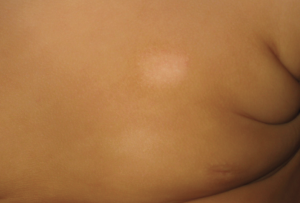Chapter 13: Disorders of Pigmentation
Hypopigmented and Depigmented Lesions: Pityriasis Alba
What is it?
Pityriasis alba is a common condition seen in children, most commonly in children with darker coloured skin. It is thought to be a result of low-grade inflammation from a mild dermatitis. It often coexists with dry skin and atopic dermatitis.
What does it look like?
Pityriasis alba is characterized by hypopigmented round to oval patches on the cheeks, neck, upper trunk and proximal extremities. They may be slightly scaly. The lesions are well-circumscribed but may not have very sharp edges and might show follicular prominence at the border. Usually it is asymptomatic but in some patients it might be slightly itchy. Pityriasis alba often appears worse after sun exposure due to the contrast caused by tanning of the surrounding skin.
How is it treated?
Pityriasis alba can be treated with a mild topical corticosteroid and the use of a moisturizer to affected areas several times daily.


